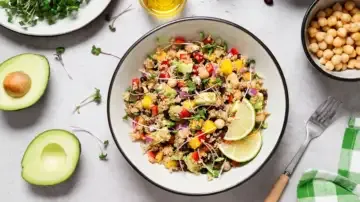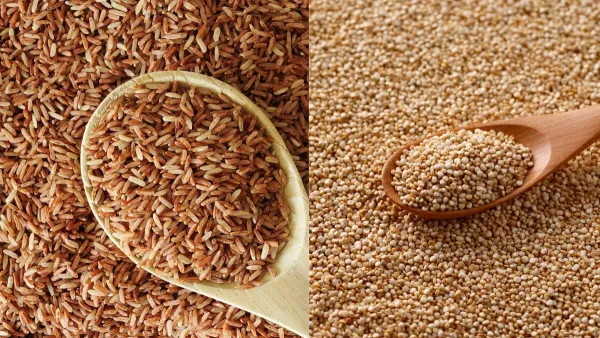Although medicines are prescribed to diabetics, food choices play a major role. Grains make a substantial difference in regulating the blood sugar level. Two of the most common grains, namely brown rice and quinoa, are excellent substitutes for refined grains. They are both packed with nutrients, rich in fibre and other essential nutrients. However, people are often confused about which grain, brown rice or quinoa, is best for healthier blood sugar level control.
Both brown rice and quinoa are easily accessible and can be cooked at home, making a great addition to the healthy platter. Brown rice is considered a staple in most Indian households and is popular for its earthy flavour and unrefined goodness. Quinoa, on the other hand, has gained global popularity as a superfood for its high protein content. Here's what you should know about whether diabetics should eat brown rice or quinoa to control their blood sugar levels.
Brown Rice vs Quinoa: The Detailed Comparisons
Nutritional Profile
Brown Rice: Brown rice is a whole grain that is packed with magnesium, manganese, vitamin B and antioxidants. It is mostly carbohydrate-rich with moderate fibre.
Quinoa: It is basically a seed which is gluten-free and is highly rich in protein, providing all nine essential amino acids. It also has more fibre, iron and healthy fats compared to brown rice.
Glycaemic Index (GI)
Brown Rice: According to the National Institutes of Health (NIH), brown rice has a glycaemic index ranging from 50 to 68, which categorises it as a medium-GI food. It does cause a gradual rise in blood sugar and can increase the spike levels when eaten in large portions.
Quinoa: As per NIH, quinoa has around 35 to 40, making it a low-GI food. Quinoa is slowly digested and helps prevent sudden spikes in the sugar levels, making it more diabetes-friendly.

Brown Rice Or Quinoa For Better Diabetes Control (Image Credits: Canva)
Satiety And Weight Management
Brown Rice: This grain provides fullness but may not keep a person satiated for long as it is mainly carbohydrates.
Quinoa: The high protein content of quinoa keeps the stomach fuller for longer, reducing the tendency to binge-eat and helping with weight management.
Digestibility And Daily Use
Brown Rice: It is easy to cook and is versatile in Indian meals like dal-chawal, pulao and khichdi. However, some people may experience bloating if consumed daily without portion control.
Quinoa: It is light on the stomach, gluten-free and can be easily digested. It pairs well with curries, salads or even as a substitute for rice in Indian dishes.
Brown Rice vs Quinoa: Which Is Better For Diabetes Control?
Both brown rice and quinoa are healthier than white rice; however, quinoa has the upper hand in controlling diabetes well. Its low glycaemic index, higher protein content and rich fibre content are great for keeping the blood sugar levels in check. On the contrary, brown rice can still be a good option when consumed in moderation, especially for those who prefer familiar flavours and textures.
If planning to manage diabetes, quinoa is a better option owing to its low GI and nutrient-dense profile. However, managing the balance and portion control is the key. To ensure blood sugar control, mix whole grains, including brown rice, quinoa, millets or oats for better results.

 Brown Rice Or Quinoa For Better Diabetes Control (Image Credits: Canva)
Satiety And Weight Management
Brown Rice: This grain provides fullness but may not keep a person satiated for long as it is mainly carbohydrates.
Quinoa: The high protein content of quinoa keeps the stomach fuller for longer, reducing the tendency to binge-eat and helping with weight management.
Digestibility And Daily Use
Brown Rice: It is easy to cook and is versatile in Indian meals like dal-chawal, pulao and khichdi. However, some people may experience bloating if consumed daily without portion control.
Quinoa: It is light on the stomach, gluten-free and can be easily digested. It pairs well with curries, salads or even as a substitute for rice in Indian dishes.
Brown Rice vs Quinoa: Which Is Better For Diabetes Control?
Both brown rice and quinoa are healthier than white rice; however, quinoa has the upper hand in controlling diabetes well. Its low glycaemic index, higher protein content and rich fibre content are great for keeping the blood sugar levels in check. On the contrary, brown rice can still be a good option when consumed in moderation, especially for those who prefer familiar flavours and textures.
If planning to manage diabetes, quinoa is a better option owing to its low GI and nutrient-dense profile. However, managing the balance and portion control is the key. To ensure blood sugar control, mix whole grains, including brown rice, quinoa, millets or oats for better results.
Brown Rice Or Quinoa For Better Diabetes Control (Image Credits: Canva)
Satiety And Weight Management
Brown Rice: This grain provides fullness but may not keep a person satiated for long as it is mainly carbohydrates.
Quinoa: The high protein content of quinoa keeps the stomach fuller for longer, reducing the tendency to binge-eat and helping with weight management.
Digestibility And Daily Use
Brown Rice: It is easy to cook and is versatile in Indian meals like dal-chawal, pulao and khichdi. However, some people may experience bloating if consumed daily without portion control.
Quinoa: It is light on the stomach, gluten-free and can be easily digested. It pairs well with curries, salads or even as a substitute for rice in Indian dishes.
Brown Rice vs Quinoa: Which Is Better For Diabetes Control?
Both brown rice and quinoa are healthier than white rice; however, quinoa has the upper hand in controlling diabetes well. Its low glycaemic index, higher protein content and rich fibre content are great for keeping the blood sugar levels in check. On the contrary, brown rice can still be a good option when consumed in moderation, especially for those who prefer familiar flavours and textures.
If planning to manage diabetes, quinoa is a better option owing to its low GI and nutrient-dense profile. However, managing the balance and portion control is the key. To ensure blood sugar control, mix whole grains, including brown rice, quinoa, millets or oats for better results.